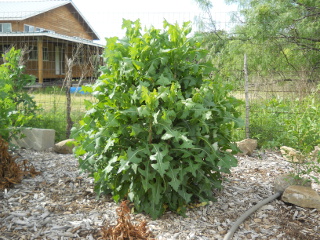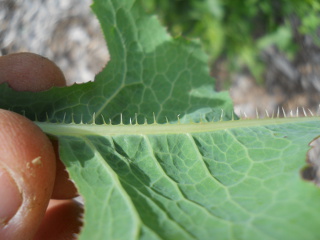Well, since our blog post on curly dock, a humanly-edible weed, we’ve discovered that it appears what I thought was curly dock is actually prickly lettuce, a species of wild lettuce. So, it was actually more “lettuce” than I thought. 🙂 I originally went with curly dock because when I did an internet search for weeds that look like lettuce, that came up and wild lettuce didn’t that I saw; and also because in the Texas weed book we have, curly dock was the closest match. Thankfully it ends up being an edible too. :O
At any rate, to me they do look similar, but the lettuce we have growing fits closer to the prickly lettuce description. Here is the Texas Foraging site on prickly lettuce. It has vitamin A & B, and minerals, and apparently doesn’t have the oxalic acid problem, although it says if you eat too much it can upset your stomach.
From what I’ve experienced, their taste varies — sometimes a little bitter, sometimes not at all. But it all goes well in a salad!
Here are some more pictures, that look much more like this type of wild lettuce:
As I’m eating them raw, to get rid of the little pricklies, I just run my finger down the leaf spine, and that pretty much takes them out.
As before, we are grateful to the Lord for granting this provision directly off the land!
— David


Curly dock is another name for yellow dock, so named because the roots are yellow. Harvest them in the fall, clean and then chop the roots into pieces and dry thoroughly. Make a tea by simmering covered for 20 min. The roots are very high in iron.
Hi Nancy,
Thanks for the information and taking the time to share!
— David
Love your site.
Here are some foragers plant ID sites…
https://identifythatplant.com/foraging-resources/
and
http://www.ediblewildfood.com/foraging-for-food.aspx
Hi Lili,
I don't typically post links, but these look at least legitimate, although I won't personally vouch for their veracity.
I do thank you for taking the time to send them, and thanks for saying hello!
— David
Hi Mr. Sifford,
Have you ever tried them for pain relief? Some of the stuff I read made it sound like wild lettuce and prickly lettuce could both be used for pain relief but that one might be more potent than the other. Any thoughts?
Thanks,
Stewart
Hi Mr. S,
I had heard that too but haven't specifically tried it. There is a kind of milky substance in the leaf stems…I've wondered if it was in that. I also wonder if you have to eat a lot of it to get an effect, and then the things I've read said you can get an upset stomach from too much of the lettuce.
I'll try to keep it in mind in the future. We actually don't really have any around us right now that I see, and we got rid of everything from our gardens.
Thanks for saying hello!
— David